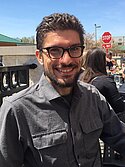Natural and Anthropogenic Landscape Effects on Amphibians in the Northern Great Plains: Genetic Population Structure, Connectivity, and Local Adaptation in Northern Leopard Frog (Rana Pipiens)

Justin Waraniak, a PhD student in the Environmental and Conservation Sciences Program with a concentration in Conservation Biology at North Dakota State University. I specialize in population genetics and community ecology with a particular focus on aquatic organisms including fishes and herpetofauna. I graduated from the University of Michigan with a Bachelors of Science in Ecology and Evolutionary Biology and a minor in Asian Language (Mandarin Chinese) in 2014 and completed my Masters of Science in Fisheries and Wildlife with a concentration in Ecology, Evolutionary Biology and Behavior from Michigan State University in 2017.
Natural and anthropogenic landscape effects on amphibians in the northern Great Plains: Genetic population structure, connectivity, and local adaptation in northern leopard frog (Rana pipiens)
Research Abstract
The northern leopard frog, though common in North Dakota, has become imperiled throughout the western portion of its range due to climatic stressors and loss of habitat from land-use change. Agricultural land use has greatly expanded in the northern Great Plains and is continuing to replace natural prairie and prairie pothole wetlands on the landscape. As a result, amphibian populations and the populations of other wetland biota are at risk of becoming fragmented.
In addition to replacing habitat, agriculture can introduce new stressors into remaining wetland habitats in the form of nutrient loading from fertilizers or toxicity from pesticides. In experimental settings, high concentrations of agricultural pollutants are known to have negative effects on wetland-dependent taxa, including amphibians, however little work has been done to identify population-level effects in real-world systems.
Project Objectives:
- Identify population structure and assess genetic health of northern leopard frog populations in south-central North Dakota
- Develop a model of genetic connectivity to determine what landscape features affect gene flow among northern leopard frog populations in the Prairie Pothole Region
- Test genomic markers for evidence of selection associated with agricultural land use to determine possible stressors on northern leopard frog populations
Progress
Genetic sample collection and bioinformatics processing
We collected genetic samples from northern leopard frogs from 28 samples sites (20 frogs per site) in the Lake Oahe and James River basins for genomic analysis. Frogs were genotyped using a BestRAD RAD-seq approach to build genomic libraries that were sequenced at the University of Minnesota Genomics Core. Sequences were aligned to the bullfrog (Rana catesbeiana) genome to identify biallelic SNP (single nucleotide polymorphism) loci in our samples. After quality filtering of genomic data, the final dataset included over 2800 SNPs genotyped for 315 individuals from 22 sample sites.
Population structure and genetic diversity
Multiple structuring analyses, including the program STRUCTURE, discriminant analysis of principal components (DAPC), and fineradSTRUCTURE, suggested that gene flow was high throughout the study area and only showed some weak spatially-organized population structure among our sites. Likewise, measures of genetic diversity (heterozygosity, inbreeding coefficients, and nucleotide diversity) were similar for sites throughout the study area and were not correlated with the amount of nearby agricultural land use.
Models of genetic connectivity
Models of genetic connectivity were generated by comparing measures of genetic distance between sample sites to landscape resistance values based on circuit theory which treats gene flow like electricity running through a circuitboard. Areas with low resistance allow gene flow to move through easily, while areas with high resistance prevent gene flow. Combinations of 11 landscape variables including land use, topography, and environmental variables related to desiccation risk in amphibians were tested against the measures of genetic distance to find the landscape factors that best explained the spatial patterns of genetic differentiation among our sample sites. The best models suggested that land use and topographic roughness were the most important landscape variables explaining genetic differentiation of northern leopard frogs in this part of the Prairie Pothole Region.
Conference/Seminar Presentations
Waraniak JM, Fisher JDL, Purcell K, Mushet D, Stockwell CA. Landscape genetics reveal broad and fine-scale population structure due to landscape features and climate history in the northern leopard frog in North Dakota. Oral presentation at the American Fisheries Society/ The Wildlife Society 2019 Joint Annual Conference, Reno, NV.
Waraniak, J., D. M. Mushet, and C. A. Stockwell. 2020. Population connectivity in an agricultural landscape: Land use effects in northern leopard frog (Rana pipiens) in the Prairie Pothole Region. North Dakota Wildlife Society Chapter Meeting, Feb 12-14, 2020, Bismarck, ND.
Waraniak, J., D. M. Mushet, and C. A. Stockwell. 2020. Conservation genomics in the northern Great Plains: Assessments of genetic diversity, population structure, demographic history, and anthropogenically mediated selection in the northern leopard frog. Invited symposium at Northern Prairie Wildlife Research Center, Feb 27, 2020, Jamestown, ND.
Waraniak, J., D. M. Mushet, and C. A. Stockwell. 2020. Population connectivity in agricultural landscapes: Land use effects on gene flow in northern leopard frog (Rana pipiens) in the Prairie Pothole Region. North American Congress for Conservation Biology Virtual Conference, Jul 27-31, 2020, online.

Craig Stockwell
Biological Sciences
Office: Stevens 119
Telephone: 701-231-8449 Email: craig.stockwell@ndsu.edu

David Mushet
Chief-Climate and Land Use BranchAgicultural and Biosystems Engineering
USGS


